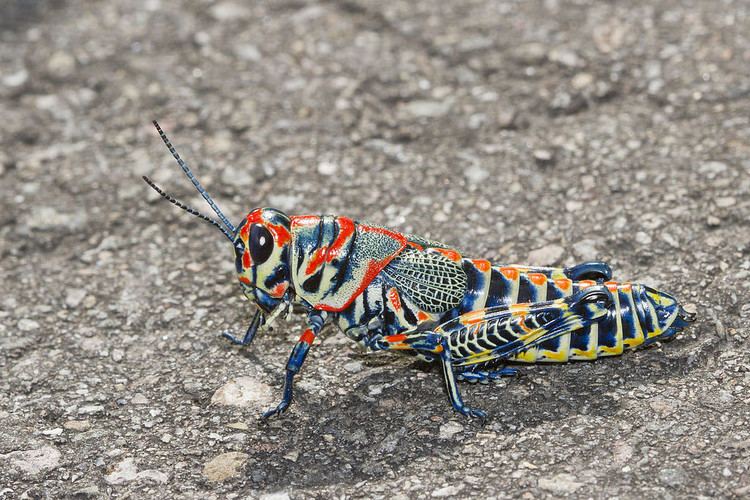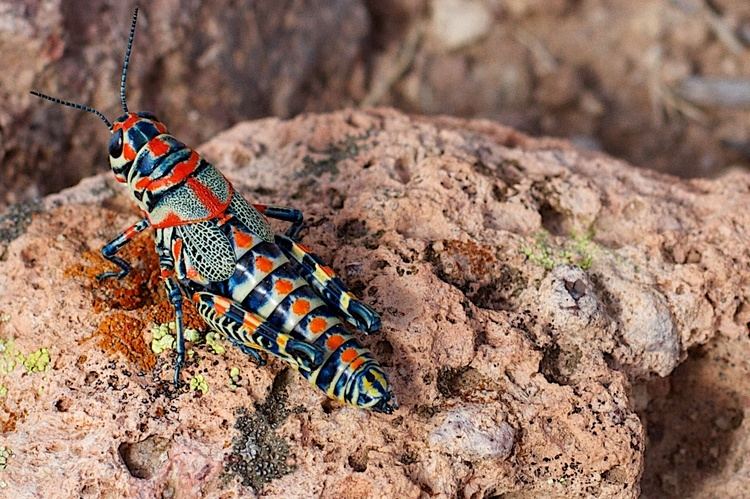Tribe Dactylotini Scientific name Dactylotum bicolor Rank Species | Genus Dactylotum | |
 | ||
Similar Giant mesquite bug, Sphaerocoris annulus, Phylliidae, Burara amara, Hypercompe | ||
Rainbow grasshopper dactylotum bicolor
Dactylotum bicolor, also known as the rainbow grasshopper, painted grasshopper, or the barber pole grasshopper, is a species of grasshopper in the family Acrididae. It is native to the United States, Canada and northern Mexico and is aposematically colored. It was first described by the German entomologist Toussaint de Charpentier in 1843.
Contents
- Rainbow grasshopper dactylotum bicolor
- Munchies while mating dactylotum bicolor
- Description
- Distribution and habitat
- Biology
- References

Munchies while mating dactylotum bicolor
Description

Dactylotum bicolor grows to an average length of about 20 mm (0.8 in) for males and 35 mm (1.4 in) for females. It is mainly black with distinctive reddish and yellowish markings, a pale green prothorax and pale green wingpads. The tibia of the hind leg bears six to eight spines. This species does not develop wings and is unable to fly.
Three subspecies are recognised:


The coloring varies across the insect's range, with D. b. pictum being black with little red, D. b. variegatum having distinct red markings, and D. b. bicolor having a purplish or violet sheen to the background black color.
Before the discovery of Dichroplus silveiraguidoi in Uruguay in 1956, Dactylotum bicolor had the lowest known number of chromosomes among grasshopper species, with seventeen acrocentric chromosomes.
Distribution and habitat
It is found in shortgrass prairie, desert grasslands, thinly vegetated areas and alfalfa fields throughout the western Great Plains of the United States (and southern Canada), southward to Arizona, New Mexico, Texas, and into northern Mexico.
Biology
Eggs are laid in soft soil in several batches of about one hundred. These overwinter and hatch in late spring or early summer, with adults being present until September or October. There is a single generation each year.
Although adult rainbow grasshoppers are polyphagous and feed on many species of plant, the nymphs feed entirely on Wright's false willow (Baccharis wrightii) in Arizona and New Mexico. It has been found that the nymphs orientate themselves with regard to the whereabouts of the sun, positioning themselves around the bush so as to thermoregulate (keep their body temperature within an acceptable range). In the morning and evening they feed near the ground on whichever side of the bush is in full sun, but in the middle of the day they hide themselves in the shady centre. At night they roost in the top branches of the bush, but this may primarily be to avoid ground-based predators.
The insect's coloration has been shown to be aposematic in an experiment in which little striped whiptail lizards were used as the predator. These brightly-colored grasshoppers were less attractive to the lizards as food than cryptically-colored Trimerotropis sp of similar size, even though the lizards were unfamiliar with the rainbow grasshopper, which was not present in their natural habitat. The lizards may previously have encountered other prey with warning colors such as stink bugs, seed bugs and velvet ants. The insect is also distasteful to birds.
